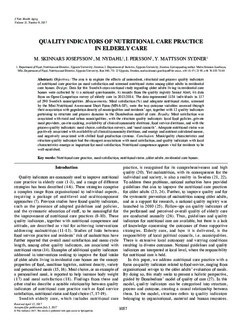| dc.contributor.author | Josefsson, Malin Skinnars | |
| dc.contributor.author | Nydahl, M. | |
| dc.contributor.author | Persson, I. | |
| dc.contributor.author | Sydner, Y. Mattsson | |
| dc.date.accessioned | 2018-03-23T11:32:47Z | |
| dc.date.available | 2018-03-23T11:32:47Z | |
| dc.date.issued | 2017 | |
| dc.identifier.citation | Skinnars Josefsson, M., Nydahl, M., Persson, I., & Mattsson Sydner, Y. (2017). Quality indicators of nutritional care practice in elderly care. The journal of nutrition, health & aging, 21(9), 1057-1064. | nb_NO |
| dc.identifier.uri | http://hdl.handle.net/11250/2491893 | |
| dc.description.abstract | Objectives: The aim is to explore the effects of antecedent, structural and process quality indicators of nutritional care practice on meal satisfaction and screened nutritional status among older adults in residential care homes.
Design: Data for this Swedish cross-sectional study regarding older adults living in residential care homes were collected by i) a national questionnaire, ii) records from the quality registry Senior Alert, iii) data from an Open Comparison survey of elderly care in 2013/2014. The data represented 1154 individuals in 117 of 290 Swedish municipalities.
Measurements: Meal satisfaction (%) and adequate nutritional status, screened by the Mini Nutritional Assessment Short Form (MNA-SF), were the two outcome variables assessed through their association with population density of municipalities and residents' age, together with 12 quality indicators pertaining to structure and process domains in the Donabedian model of care.
Results: Meal satisfaction was associated with rural and urban municipalities, with the structure quality indicators: local food policies, private meal providers, on-site cooking, availability of clinical/community dietitians, food service dietitians, and with the process quality indicators: meal choice, satisfaction surveys, and 'meal councils'. Adequate nutritional status was positively associated with availability of clinical/community dietitians, and energy and nutrient calculated menus, and negatively associated with chilled food production systems.
Conclusion: Municipality characteristics and structure quality indicators had the strongest associations with meal satisfaction, and quality indicators with local characteristics emerge as important for meal satisfaction. Nutritional competence appears vital for residents to be well-nourished. | nb_NO |
| dc.publisher | The Journal of Nutrition, Health & Aging | nb_NO |
| dc.rights | Navngivelse 4.0 Internasjonal | * |
| dc.rights.uri | http://creativecommons.org/licenses/by/4.0/deed.no | * |
| dc.subject | nutritional care practice | nb_NO |
| dc.subject | meal satisfaction | nb_NO |
| dc.subject | nutritional status | nb_NO |
| dc.subject | older adults | nb_NO |
| dc.subject | residential care homes | nb_NO |
| dc.title | Quality indicators of nutritional care practice in elderly care | nb_NO |
| dc.type | Journal article | nb_NO |
| dc.source.pagenumber | 1057-1064 | nb_NO |
| dc.source.volume | 21 | nb_NO |
| dc.source.journal | The Journal of Nutrition, Health & Aging | nb_NO |
| dc.source.issue | 9 | nb_NO |
| dc.identifier.doi | 10.1007/s12603-017-0970-8 | |

